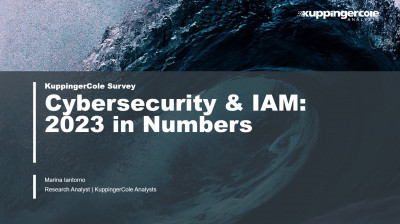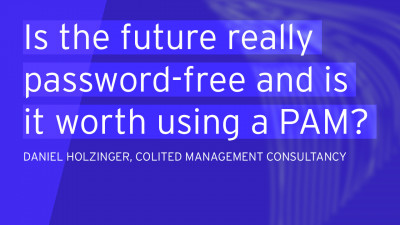My name is Andrea Russ. I'm the head of go to market for SAP customer data cloud. You might know us from before the acquisition. We come from giga. We've been in market for the last 10 years. And we're all about building trusted digital experiences and trusted relationships in between you as a business and your business partners and your customers.
And today we're really going to be reviewing what are the challenges, the barriers and the trends in the market that we see that are, that need to be harnessed for you to be able to build trusted relationships by knowing your customers, managing their consent and making sure that you provide a superior customer experience to them. But first of all, I'd like to challenge you challenge you in the way today, you are providing a service, a product to your customers. We are all quite familiar with the fact that customer experience is paramount.
We expect more and more B2C kind of interactions by B2C. I mean, we all quite used to Uber, Lyft Deliveroo, your mobile bank or whatever this is. And typically you have a great experience with these, with these, with these services. And you expect the same level of experiences throughout your interactions, whether you are in a consumer mode or a business mode thing is you're not just delivering a product or a service anymore. You're delivering an experience. And this is important for you in terms of brand value. And of course, revenue think about the coffee paradigm.
If you're selling coffee beans, you are selling these in term in cents. Then if you're selling coffee cups and you go in the morning to your local coffee shop, you're paying like a Euro or a Euro 50 to get your coffee. And then you go to Starbucks and you get a proper customer experience, starting from a smell music, people being called by your name.
If they get it right, once your coffee's ready and you start to be paying three to five euros for that coffee cup, a coffee is the same. It's the same grounds, the same beans it's brewed in exactly the same way yet.
It's a different customer experience and you are willing, I am willing to pay more for it. So really what's what's happening there is that the most precious resource you have in your business's not the product or the customers, it's the relationship you're able to build with these customers. So to create loyalty over time and continuing promoting your brand value. But the currency that is actually used in terms of creating and building that relationship is based on data.
If you, if you do get the data wrong, or if you're using the data in a wrong manner, without the user's explicit consent, then you're diminishing the brand value and you're diminishing the revenues that you can expect out of it.
Problem is that today, and this is a source from Bain and company, 80% of CEOs already believe that they're providing a superior experience to their customers. When you look at it at the other end of the spectrum, 8% of customers actually believe they're getting a superior experience. So there is clearly a disconnect.
There is clearly a gap, a customer experience gap in between what businesses are providing or think they're providing and what we, as users, as business users or consumers are actually getting as an experience. So why is it so hard and what are the reasons for this gap in terms of customer experience?
Well, we really see three key mega trends in the market, which are applicable to both B2B and B2C interactions. Number one is personalized omnichannel experiences. We expect to be able to have the, exactly the same service in a personalized manner independently of the accessing channel, whether it is via a smart TV, an a mobile app, a digital property, a call center or offline, we expect to be recognized by our name.
We expect companies to know our preferences, to manage our consent in a proper way.
And this is applicable to both B2B and B2C, but this personalized omnichannel access and experience is of course needed, but not at any cost. We all know the value of our own personal data. We don't want the personal data to be leveraged or reduced for other purposes than the ones we've agreed to. Hence the importance of both transparency and control transparency for us as users, to be able to understand to whom we have provided our data. What is this data used for? And of course, control in terms of providing access to, but also revoking access to the companies that are leveraging our data.
And also the third mega trend that we see in the market is the explosion of customer data explosion, thanks to IOT, thanks to multiple touchpoints, but the problem is, and as we were gonna be seeing in the next few slides is that the explosion of customer data does not easily allow for a customer 360 view.
It's always very, it's often siloed in terms of data, meaning that yes, there is a lot of data that enterprises can build upon, so to provide a solid customer experience, but yet we're still missing the tools that enable to orchestrate the data easily and provide a coherent, seamless customer experience to the users. And that's why we believe we need a paradigm shift.
So you might remember in 1968, during the summer Olympics, when the Fosbury flop was introduced, this was introduced because instead of landing on sand, suddenly you were able to land on foam and therefore jumping backwards was an option, which clearly wasn't an option beforehand. And we believe we be, we, we actually need a similar paradigm paradigm shift going forward, where you need to put customers at the center of interaction, but with the new concept, which is trust, if there is no trust in between the customer, the consumer and the brand, there is no relationship that can be built.
It's like a friendship it's built on trust. So why is it so difficult to build trusted relationship with customers? Let's look at the three main barriers that we're seeing in the market. First of all, don't be a data hoarder.
I mean, like look at some political parties. I think of France, as an example, think of Cambridge Analytica and others. A number of companies today are still collecting data without the specific purpose.
The idea, the idea being that the more data you have about a user, the better you're able to personalize the user experience true, but not true. Why not true? Because today you cannot just, you cannot just harness data without the users knowing about it without the user giving his explicit consent. And clearly there are a number of privacy policies that, that have been put in place as well to cover, to respect our privacy rights as consumers and as businesses.
So whose data is it?
Anyway, the answer is easy. It's our own data. We all recognize the importance of our data. We all recognize that it's our own data and we are the ones that should be responsible for it and also in charge for it. So we've come a long way from the European union DPA, back in 98, we've seen the Australian privacy principles. We've seen countries such as China and Russia coming up with data regulations for which there is a data residency component where it needs to reside in country.
Of course, for all familiar with GDPR, which was introduced in may last year, we're seeing the California privacy act, which, which is going to be ratified in the next few weeks. Brazil also recently came up with its own privacy regulation and we're expecting other countries such as Chile, Peru, and others to come up in Latin America with privacy regulations.
And clearly we expect Africa as well, predominantly South Africa to start, and then continuing to come up with privacy policies that protect consumers and businesses in terms of data.
And the third aspect of faith is really about data silos. I'll give an example. I was last week, sorry, two weeks ago, last week I was at Sapphire in Orlando two weeks ago. We were at with a UK customer of ours in the sports industry. They have a great brand that I cannot mention, but they have a great brand. They have a lot of that follow the brand very, very closely, and they have around 48 different touchpoints. It being offline data, behavioral data, marketing data, CRM data up based data in stadium data, which is great problem is that all of these data points are siloed.
They don't talk to each other. And this clearly creates both issues in terms of providing a seamless experience to the customer, as well as a number of gaps, both in terms of security and privacy.
So everything we've seen so far really pertains to both B2C and B2B, but we also see a number of B2B specific challenges. And typically when business to business relationships, in terms of engagement of both customers and partners, we see challenges in terms of onboarding new customers, partners, and suppliers.
Very often, this is still with a lot of human touch, which is our prone time consuming and clearly costly. And this results in complicated and slow processes, which also result in poor customer experiences as we have seen, it's not because we're in a B2B environment that we don't expect the same kind of experience that we do in a consumer world with the Ubers, the Lyfts, and so on, so forth.
And finally, if you have data silos and you, if you have human touch across the interactions in between a business and its suppliers or customers, this also creates a number of business risks with both compliance and security.
And that's why we believe that digital business and it leaders are looking for systems in order to accelerate, simplify, and protect the interaction accelerate in terms of increasing the conversion rates from a prospect to an actual supplier or distributor, providing them with personalized experiences throughout the interaction, which clearly provides a faster time to market reduces costs and can increase revenues.
Businesses are looking to simplify the end to end identity life cycle management in order to easily onboard manage and off board as required new customers, suppliers, distributors, and finally protecting against privacy and security gaps that are created by these high touch human interactions. And that's exactly where we come in. So giga now, SAP customer data cloud, we've been around for the last 12 years. We really focus in providing solid digital, trusted customer experiences. We do. So for over 500 enterprises in the world, global enterprises today, we manage 1.7 billion identities.
So yes, we do have a fairly good view of what's happening in the market, in the identity space and in the security space, we launched our consent product around two years ago, and we now, man, we have managed since then 2 billion content cons consent transactions. And we have over 400 million logins per month, 20 billion API calls per month. So it is a very solid infrastructure trusted by our customers in order to provide seamless customer experiences built on trust. And we do so by providing really two key components.
One is a customer identity and access management solution easily enabling customers to log, to register, log in and access through any channels, nearly any channels. And number two, our enterprise consent and preference management capability. Because as we've seen, you cannot manage identities without the users explicit consent and both the identities and the consent need to be available and orchestrated throughout the digital stack of the enterprises.
So to provide a consistent, seamless experience throughout the various touchpoints that customers expect to be able to use.
So let's have a look at the various solutions that we bring to market. Number one is clearly our customer identity and access management for B2C, for consumers, where we provide all of the identity life cycle and authentication capabilities. So think about username and password access. Think about mobile phone access, social login, federated identity, and so and so forth.
We provide all of these single signon capabilities and single account so that large enterprises with multiple brands present in multiple countries can have a coherent view of the same user, because I might be buying pet food, coffee, water, but not being able to be recognized by the same brand as the same user, which clearly is an issue. Number three, we provide all of the self-service capabilities for users to be able to self-serve easiest example, being all the password reset, as opposed to be calling a call center, why not allowing users to themselves.
And finally, all of this is built in a cloud native approach, full software as a service, bringing all of the security and compliance that you require through property around your business. But at the same time, as we've seen throughout these days, the IM market, the identity and access management market is really consolidating you. You used to have companies that were focusing on B2 E some companies that focusing on B2B others, focusing on B2C as we were.
And we've recently introduced actually we launched last week, our ACP customer identity and access management solution for B2B organization specifically. So to speed up the onboarding, the management of customers, partners, and suppliers, and we do so with our organization and access management capabilities, all of the identity life cycle management of the third party companies, the authentication management in order to provide a secure access to your companies, intellectual property, data, portals, and so on and so forth.
We provide dynamic policy based access control, both in a course grained manner, which is the easy one and fine grained manner, which is way more complex, clearly all of the consent and preference management capabilities that go with it, as well as all of the user self-service capabilities and most importantly delegated administration, so that when you're interacting with your customers, your partners, it is not your it team that is spending time in managing those interactions.
You're able to delegate your customer's partners and suppliers, all of the administration capabilities and access controls. And the beauty of it is that it's available.
Now, we launched it last week. We actually encourage you to come and visit us on our stand, following this presentation so that we can go into more details then because we have the identity of the user. We also need to be able to manage his consent.
So with all of the preference and consent capture at the right moment, all of the version controls that goes with it. So to always have fresh.
So to all fresh consent of the user, in terms of privacy policies, terms of service, and of course, consent for my data to be used for marketing purposes, we need to be able to accurately govern the records throughout the digital stack. So if I change something online versus calling a call center, this is always up to date as well as what I call the tip of the iceberg, all of the self-service preference capabilities, enabling users to self-serve themselves.
And now that we have the identity of the user and the consent of the user to leverage their data, of course, we need to be able to orchestrate this back and forth. Let me an example, three weeks ago, I was late buying my wedding anniversary gift for my wife, like more or less every year.
So I went online, bought a new bag for my wife, accepted very rapidly, the terms and conditions, privacy policies, and the consent for my data to be used for marketing purposes. And then I finalized my purchase. I received an email confirming.
I was going to receive the gift on time for my wedding anniversary. Good done. And in the afternoon I changed my mind and I wanted to remove my consent for my data, not to be used for marketing purposes, but this time I called up the call center and I asked the agent to remove my consent. Now this call center agent needs to be able to update this consent change that I've just expressed. So that a solution such as ours, our customer data cloud solution is able to get this change of consent and broadcast it to the rest of the digital stack.
So that, for example, in the evening, I do not get a promotional email from that specific brand.
Now my time is up. So I'd like to leave you with the three big items that we are working on for 2019. Number one is helping brands deliver global trusted relationships, and we're doing so for example, by introducing global login, the ability for a user to travel around the globe, login seamlessly on different digital properties yet not having their data being copied across multiple data centers, number two, accelerate, simplify, and protect business to business relationships.
And that's exactly what we're doing by introducing our customer identity and access management solution for B2B and number three, breaking down silos. So to evolve and complement the uni unified customer profile for the customer obsessed enterprises to provide the best possible customer experience to their customers, partners, and suppliers. So with this, I'd like to thank you and please do come and visit us on our stand. Thank you all.
So thank thank you, Andrea. We have one question here already, and it's interestingly, more or less the same question I had in mind to ask you.
So where does SAP stand on safe? So in identity, we had a lot about enabling the customer to bring his own identity and sort of broader sense.
How, what is your position on saying, you know, all of these customers might come in with different identities, not only identity created by the brand, but one brought by the customer. What is your perspective on that?
We're actually open to it from our, from our perspective I important part is to enable users then being B2C or B2B users to leverage their preferred identity, whether this is federated identity, sovereign identity, your social identity, it's really up to them from our perspective of our job is to simplify the access and the management of these identities.
So we are agnostic to the way it's approached.
Thank you. Thank
You very much, Martin,
Andrea.

















































